Multicultural Children's Literature
A 10-month Author Study
December: Gary Soto
photo from akoot.com
Soto was born and raised in Fresno, California; Fresno and the California’s Central Valley serve as the setting for many of his children’s books. Everyone in his family was either a farm worker or a factory worker, and growing up Soto worked many odd jobs to help the family as much as he could. He was a troublemaker in school, and as a child was never interested in reading. Expectations for children like him were low, Soto says: “One of the aspirations was that if we stayed out of prison, we would be fine. As long as we did that, there was a reason to be proud.” He didn't discover his love of reading and writing until junior college. According to Soto, he discovered poetry by accident, picking up an anthology in the school’s library; he was immediately hooked. He transferred to Cal State to study English, and has been writing poetry and fiction ever since. Soto describes his style:
A lot of my work seems autobiographical, because I write a lot about growing up as a Mexican American. It's important to me to create and share new stories about my heritage. It's a huge part of my life. If you read my poems and stories, you might wonder which things really happened to me... For me, the joy of being a writer is to take things I see and hear and then rearrange them. I like to tamper with reality and create new possibilities.
Gary Soto describes how he discovered his love of reading and writing late, motivated by an "internal drive." His story shows the importance of making books with relatable characters available to young people in order to spark an early love of reading and the motivation to stay in school.
video from CollegeDaySJ
Today Soto resides in Berkeley. He has written 44 books for children and young adults, as well as many collections of poetry and memoirs. Soto is Chicano, or Mexican American, and most of the characters in his stories are young Chicano boys and girls as well. Most of his books are published in both English and Spanish. Soto's characters also speak Spanglish, switching between English and Spanish in conversation. His books all feature a glossary of Spanish terms as well. As with November author Monica Brown's books, while reading Soto's to the class I get to call on my expert Spanish speakers to teach us the meaning of the Spanish words.
Too Many Tamales
1993 Puffin Books, New York
Written by Gary Soto
Illustrated by Ed Martinez
image from GoodReads.com
Chato's Kitchen
1997 Puffin Books, New York
Written by Gary Soto
Illustrated by Susan Guevara
image from GoodReads.com
The Old Man and His Door
1996 Turtleback, New York
Written by Gary Soto
Illustrated by Joe Cepeda
image from PublishersWeekly.com
Snapshots from the Wedding
1997 Putnam & Grosset, New York
Written by Gary Soto
Illustrated by Stephanie Garcia
image from GarySoto.com
Big Bushy Mustache
1998 Knopf Books, New York
Written by Gary Soto
Illustrated by Joe Cepeda
image from Eduplace.com
My Little Car / Mi carrito
2006 Putnam, New York
Written by Gary Soto
Illustrated by Pam Paparone
image from GarySoto.com

Wonderful Books by Gary Soto
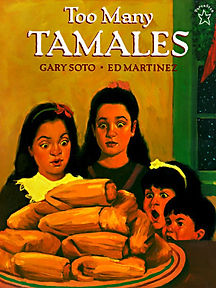
Soto does an excellent job of writing young characters that are relatable for students. In this story, Maria helps her mother prepare tamales for Christmas dinner, and when her mother leaves the kitchen Maria tries on the diamond ring that her mother left on the counter. Only later does Maria realize that she's lost the ring - and that it must be cooked into one of the tamales! I used this story to teach a reading comprehension strategy: making predictions. I enjoyed reading this story because the students really related to poor Maria's dilemma (everyone has had the experience of having to confess some wrongdoing to a parent!) and were quite invested in the outcome. They gasped and moaned aloud when the ring was the lost and were both anxious and amused as Maria enlisted the help of her cousins in eating the tamales to find it. It's always fun to share a story that gets such a strong response from the kids! See my lesson below.
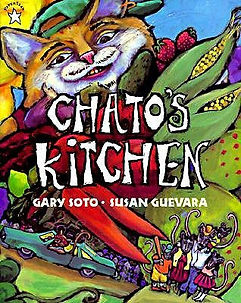
Chato the gato is a cool, low-riding cat who lives in an East LA barrio. To his delight, a family of mice moves in next door, and Chato invites them over for dinner. His intentions are less than honorable, but he gets a surprise when the mice bring over a friend of their own, Chorizo the weiner dog. This is the first of 3 Chato books that Soto has written, and the students fins them all very funny. They enjoy Susan Guevara's bright illustrations as well and the books are a favorite for looking through during free time. They feature not only words but familair expressions and slang in Spanish, and my expert Spanish speakers were excited to translate for the rest of the class. See also Chato and the Party Animals and Chato Goes Cruisin'.
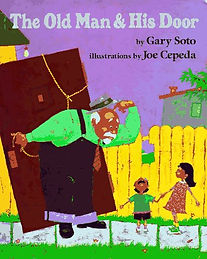
The Old Man and His Door is a story about an old man who's hard of hearing - and hard of listening to his wife! She reminds him to bring the pig, el puerco, to the barbeque, and he mistakenly brings the door, la puerta, instead. The students, of course, found this mistake hilarious. I asked my resident Spanish speakers to define puerco and puerta for us and wrote the words on the board. It's a funny story and a great book for teaching what a difference in meaning a few letters can make, whether in English or in Spanish.
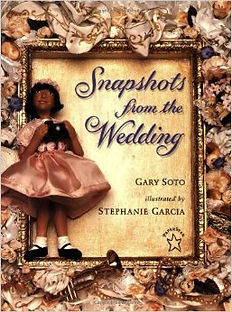
Snapshots from the Wedding, as the name suggests, depicts a series of moments from a Mexican wedding. Maya, the flower girl, narrates the events of the day. The book is arranged like a wedding album, and Maya describes the “snapshot” on each page. Stephanie Garcia illustrates Snapshots from the Wedding; each snapshot is a 3-dimensional scene inside of a frame made from clay, paints, wood, fabric, and other small objects (see photo above for an example). Garcia won the Pura Belpre Award for Illustration in 1997 for this book.
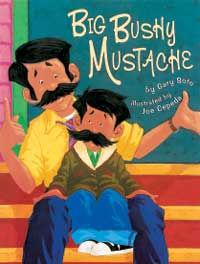
The importance of family is a theme evident in many of Soto's books, inculding Big Bushy Mustache. Ricky picks out a big bushy mustache, like his Dad's, as his prop for the class's Cince de Mayo play. Ricky likes it so much that he wears it walking around town on his way home from school; the students laughed at the reaction he gets! Kindergarteners admire the adults in their lives, be they parents, grandparents, aunts, incles, or older siblings. They were eager to share the ways in which they wanted to be like their loved ones.
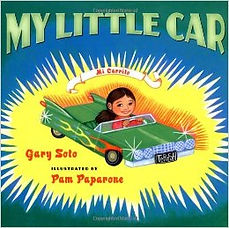
Teresa's abuelo gives her a pedal-powered car for birthday, and Teresa loves showing it off in the neighborhood and at the playground. She doesn't take care of the car, however, and it falls into disrepair. One day she finds she needs it when she's escaping from a neighborhood dog; Abuelo helps her to repair it, and she learns a valuable lesson about taking care of her things. The kids enjoyed the story becasue the idea of driving a flashy new car around town was exciting. I enjoyed the story because it allowed me to teach about the moral, or what the author means for his story to teach us; I related it to taking care of the supplies in our classroom, of course!